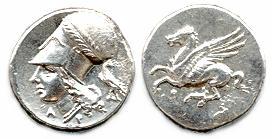| REFERENCE INDEX | HOME | SALES GALLERY |
PEGASUS
The origins of Pegasus, the mythical winged horse, are entwined with various other ancient myths. It can be tracked back to the story of Poseidon who, taking the form of a horse (or in some versions a bird), seduced Medusa in a temple dedicated to Athena. Athena was offended by this this sexual use of her temple, so she turned Medusa's hair into serpents. Later, when Perseus decapitated Medusa, Pegasus was born of Medusa's blood.
Pegasus became the mount of Bellerophon after being caught with the aid of a golden bridle given to him by Athena. What is lesser know is that Bellerophon was originally called Hipponous (Hippo means horse in Greek), the son of Glaucus who was a ghost known to frighten horses.
 |
While Pegasus appears on many ancient Greek coins, the images on Corinth's coins are best known (with Athena on the other side of the coins). As far as we have been able to determine, Corinth uses the image of Pegasus as a reference to Bellerophon, who only recieved that name after murdering a Corinthian named Bellerus. At first vilified, a plot was invoked to send Bellerophon on a series of tasks, with the expectation that he would perish in the attempts (sounds a little like the tasks of Heracles). On one of the tasks, while mounted on Pegasus, Bellerophon killed the Chimaera. On another he defeated the tribes of the Solymia and the Amazons. Eventually, having completed the tasks, Bellerophon was received as a hero.
If you entered this page from a coin description, use the back button to return to that position.
Mythology Index
| Main index | Reference Index | Home page |
Copyright © 2000 R & T Enterprises Ltd.